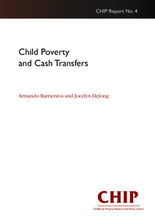This paper is one of a series of working papers, reports and policy briefings on different aspects of childhood poverty published by the Childhood Poverty Research and Policy Centre (CHIP). This report discusses the role of cash transfers in the reduction of child poverty in developing and transition countries. Recently, there has been an increasing emphasis on targeted cash transfers as a key instrument in reducing poverty, deprivation and vulnerability among children and their households. Cash transfers, together with redistributive tax policies, have a strong record in reducing childhood poverty in northern countries. Lessons from this experience are also of increasing interest in policy to tackle childhood poverty.
Transfers to poor families are provided both in-kind and in-cash. Both have advantages and disadvantages. In-kind transfers can guarantee consumption of key goods and services and maximise political support for these programmes. However, they require a great deal of administration and, when offered on a large scale, can distort markets. Though cash transfers can be used for non-essential goods, they give recipients more flexibility, and are becoming increasingly common in developing and transition countries as a tool to tackle childhood poverty.
©Childhood Poverty Research and Policy Centre

